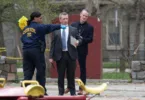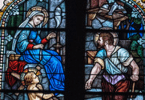
by Jim Davis
MIAMI (OSV News) — Betty Gonzalez was shivering in a jacket and two sweaters one cold night in Coral Gables. She’d lost her sales job, then her apartment. But something told her to call 911.
Two kindly police officers brought her to the Camillus House shelter in nearby Miami. Workers there gave her food, a bed — and, just as important, helped her discover a gift for art.
Since that night in late December, Gonzalez has learned to mix pastels, acrylics, watercolors, even markers in fuzzy, dreamy shapes. And like others in the Camillus art therapy class, she has even sold some of the pictures at exhibits sponsored by the shelter.
“This is heaven,” Gonzalez said after one class. “You can express. You can be yourself.”
Her sentiments were echoed by several others in the program. Some may have been living on the streets. Some may have drug problems or mental health issues. But those interviewed recently called art therapy a godsend.
“I didn’t know I was an artist,” said Immaculata Malivert, looking up from her pastel-colored picture. She said she welcomes the therapy as a sanctuary from everyday problems.
“Life outside is complicated, with different people with individual problems,” Malivert told Florida catholic, Miami’s archdiocesan newspaper. “Here, I get to empty my brain. I’m very happy here.”
Oscar Guzman lives a half-mile away. but he comes to Camillus House after his workday as a maintenance man — which he begins at 5:30 a.m. — just for a couple of hours in art therapy.
“All my life, I’ve been looking for a place like this, to have someone help me,” said Guzman, who has been in the class since late November. “Painting transports me to another place, another dimension. It’s like I’m not here on earth.”
Art therapy is just one of a broad array of services at Camillus House, run by the Hospitaller Order of St. John of God. In 1960, then-Bishop Coleman F. Carroll, the first bishop of what was the Miami Diocese, invited the religious order of brothers to South Florida to serve a growing number of refugees and immigrants.
Nowadays, the shelter houses more than 1,700 people nightly, totaling about 3,065 each year. Some 400 are in longer-term apartments on campus.
Camillus offers not only the usual food, clothing and shelter, but counseling, medical assistance, job training and substance abuse treatment. The services have made Camillus the largest and most comprehensive homeless ministry in South Florida.
Since 2016, the center has tried various therapies, including not only painting and drawing but music, yoga, gardening and performance art.
“Being homeless drives a lot of anxiety and depression,” explained Hilda Fernández, CEO of Camillus House. “Anything we can do to help clients deal with their anxiety in a positive way, we’ll try it.”
Art therapy has more than one goal. It aims at helping people tap into their doubts, fears, hopes and other feelings, and put them onto canvas. It also tries to help them rebuild a sense of confidence and self-worth.
“We’re all fragile, but these people are especially,” said David Rohn, the instructor. “They need to rebuild their spiritual self. A creative endeavor is part of that.”
The program may well reveal talents they didn’t know they had. Barry Glenn’s early pictures were all about dancers in fluid poses, hinting at his past career as a model and dancer.
He grew up in Miami and studied at the African Heritage Center. He also found work as an extra in movies such as “The Money Pit” and “Making Mr. Right.”
That bright career crashed after drugs and a stroke, he said. He found Camillus House in 2016, then discovered a new talent in visual art.
His latest pictures are portraits of entertainers, like Bob Marley and Marilyn Monroe. He also painted a cityscape, with tiny mirrors for windows.
Another dream for Glenn: writing stage plays. He said he’s contacted several talent agencies.
He now has a one-bedroom apartment on campus, where he has time and solitude to think. “Thank God for that place,” Glenn said. “It’s a place to sit and find myself.”
Betty Gonzalez’s art has likewise developed. One canvas, “Fairy Flowers,” blends pink, orange, white and violet in delicate figures. Another, “Fantasy Peacock,” has a fan-shaped design with a pearly finish.
Gonzalez has even digested her personal journey into a four-painting series. In the first, a human tries to fight through a world of blocky, garish colors. In the next, the person skywalks toward a rainbow.
Her third canvas has the subject finding a place in the world. Finally, the person shares experiences with someone else.
The series is actually about everybody, Gonzalez said. “No matter their station in life, everyone has to go through those stages. All of us are the same.”
When someone starts the class, David Rohn, the art instructor, tries to learn their artistic leanings. If they have little skill, he may just have them color line drawings. He also lets them peruse art books. He looks at each person’s work, suggesting different approaches.
He sometimes works on the art with them. And he always praises their successes. “If you make it about them, they’ll respond,” Rohn said. “It’s a moment of you and yourself.”
The students notice his caring nature, too.
“Mr. David is a sweetheart,” exclaimed Paula Ventura, getting an embarrassed smile from Rohn. “He loves us, comprehends us, inspires us. He transmits it right into our souls.”
Rohn is an artist of four decades who has exhibited his work mainly in South Florida, but also in New York, Los Angeles, Paris and Berlin. Since 2000, he has grown in his concern for the streets of Miami and people who live on them.
One of his artistic projects depicted Dante’s Nine Circles of Hell as scenes of poverty around Miami. He portrayed John the Baptist standing not at the Jordan River, but a mud puddle under an overpass.
About a year and a half ago, Rohn heard of an opening in the art therapy program at Camillus House, and he leapt to fill it. He calls the job “super-rewarding.”
“I have a relationship with all of them,” Rohn said of his students.
Camillus House holds exhibits of the artworks each spring, partnering with local businesses. Showgoers often buy the pictures, with half of the proceeds going to the artist, half to the shelter for art supplies. More than two dozen artworks were sold at the three shows this year.
“When they saw their work sold, their faces lit up,” exclaimed Fernández, the Camillus CEO, who attended a recent show at a bank in Coral Gables. “For people who have gone through so much, it was an incredible validation in their lives.”






